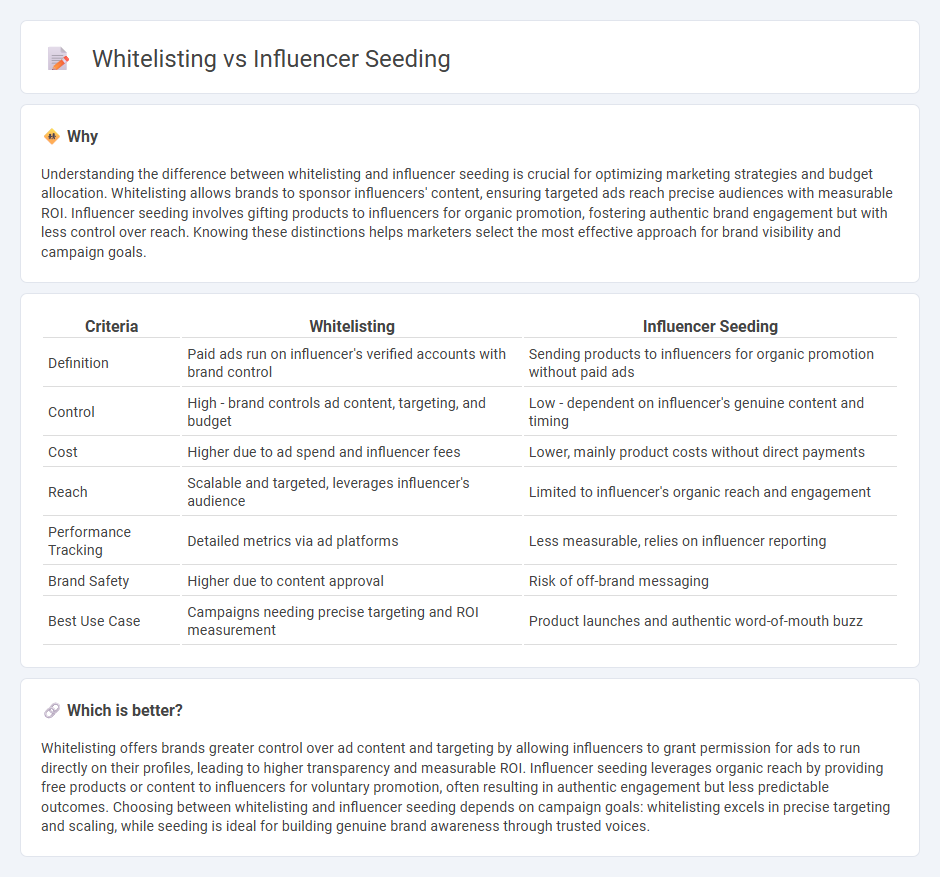
Whitelisting in marketing involves brands gaining access to influencers' social media accounts to run paid ads, enhancing targeted reach and control over campaign content. Influencer seeding focuses on providing free products or services to influencers in hopes they share genuine endorsements with their followers, driving organic engagement. Explore the advantages and strategic uses of whitelisting versus influencer seeding to optimize your marketing campaigns.
Why it is important
Understanding the difference between whitelisting and influencer seeding is crucial for optimizing marketing strategies and budget allocation. Whitelisting allows brands to sponsor influencers' content, ensuring targeted ads reach precise audiences with measurable ROI. Influencer seeding involves gifting products to influencers for organic promotion, fostering authentic brand engagement but with less control over reach. Knowing these distinctions helps marketers select the most effective approach for brand visibility and campaign goals.
Comparison Table
| Criteria | Whitelisting | Influencer Seeding |
|---|---|---|
| Definition | Paid ads run on influencer's verified accounts with brand control | Sending products to influencers for organic promotion without paid ads |
| Control | High - brand controls ad content, targeting, and budget | Low - dependent on influencer's genuine content and timing |
| Cost | Higher due to ad spend and influencer fees | Lower, mainly product costs without direct payments |
| Reach | Scalable and targeted, leverages influencer's audience | Limited to influencer's organic reach and engagement |
| Performance Tracking | Detailed metrics via ad platforms | Less measurable, relies on influencer reporting |
| Brand Safety | Higher due to content approval | Risk of off-brand messaging |
| Best Use Case | Campaigns needing precise targeting and ROI measurement | Product launches and authentic word-of-mouth buzz |
Which is better?
Whitelisting offers brands greater control over ad content and targeting by allowing influencers to grant permission for ads to run directly on their profiles, leading to higher transparency and measurable ROI. Influencer seeding leverages organic reach by providing free products or content to influencers for voluntary promotion, often resulting in authentic engagement but less predictable outcomes. Choosing between whitelisting and influencer seeding depends on campaign goals: whitelisting excels in precise targeting and scaling, while seeding is ideal for building genuine brand awareness through trusted voices.
Connection
Whitelisting allows brands to amplify influencer content by granting permission to use their posts in targeted ad campaigns, enhancing reach and engagement through authentic voices. Influencer seeding involves providing products to influencers without direct payment, fostering genuine promotion that can be effectively leveraged via whitelisted ads. Combining both strategies maximizes marketing ROI by blending organic influencer credibility with precise audience targeting.
Key Terms
**Influencer Seeding:**
Influencer seeding involves strategically providing products or services to select influencers to encourage authentic content creation and organic brand promotion. This approach builds genuine engagement and trust by leveraging influencers' creativity without controlling the messaging. Discover more about the benefits and strategies of influencer seeding for effective marketing campaigns.
Product Gifting
Influencer seeding through product gifting involves sending free products to influencers to generate authentic content and organic brand mentions, enhancing brand awareness naturally. Whitelisting leverages influencer content by obtaining permission to use it in paid social media campaigns, amplifying reach with targeted ads while maintaining influencer credibility. Explore the strategic advantages of combining product gifting with whitelisting to maximize marketing ROI.
Organic Content
Influencer seeding involves distributing products to influencers to create authentic, organic content that resonates naturally with their audience, driving genuine engagement and brand awareness. Whitelisting leverages influencers' content by granting brands paid access to promote these posts through targeted ads, amplifying reach while maintaining the authentic voice of the influencer. Discover the strategic benefits of blending influencer seeding with whitelisting to maximize organic content impact.
Source and External Links
What is Influencer Seeding? A Guide for Influencer Marketers - Influencer seeding is a strategic PR approach where brands send free products to influencers without requesting content, observing if the influencer posts authentically and engages their audience as a test for future paid partnerships, emphasizing transparency and no initial expectations.
What Is Influencer Seeding?: A Helpful Guide - GRIN - Influencer seeding helps brands build awareness and relationships at scale by gifting products to influencers who can try them out freely, resulting in authentic endorsements and saving time and costs in relationship building.
Product Seeding vs. Gifting: Everything You Need to Know in 2025 - Influencer seeding, or product seeding, differs from gifting by focusing on long-term relationships and authentic content without directives, often leading to higher-quality influencer partnerships and honest product feedback.
 dowidth.com
dowidth.com